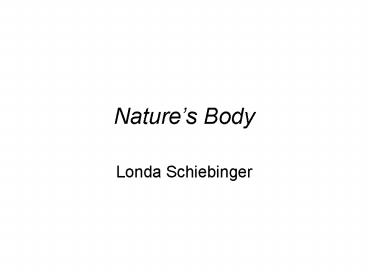Nature - PowerPoint PPT Presentation
1 / 12
Title:
Nature
Description:
Nature s Body Londa Schiebinger The Introduction Why investigate natural history? Why choose gender? Chapter One Why did plant sexuality become a priority in the ... – PowerPoint PPT presentation
Number of Views:19
Avg rating:3.0/5.0
Title: Nature
1
Natures Body
- Londa Schiebinger
2
The Introduction
- Why investigate natural history?
- Why choose gender?
3
Chapter One
- Why did plant sexuality become a priority in the
18th century? - Why did sexuality become the key to
classification? - What are Schiebingers two uses of gender in her
analysis? What does she mean by implicit or
explicit gender? - Why the sex and marriage metaphors? What were the
cultural reasons? - What is Schiebingers point about metaphors in
science? - Why no sexualization of plants in France?
- What role did radical politics in the use and
perception of these metaphors? - What curbed the use of these sexual metaphors?
4
Chapter Two
- Why was the term mammalia used to classify
animals? - What was the common term before mammalia?
- What is the origin of the term mammalia?
- What were the common historical connotations of
the breast and breast-feeding in western
culture (pre-18th century)? - How did breasts imply about female nature?
- What cultural shifts occurred in the 1750s that
altered the way one perceived of breast-feeding,
breasts, and womanhood? - How might this has influenced Linnaeus? What
evidence do we have?
5
Eugene Delacroix, Liberty Leading the People,
1830
6
Chapter Three
- Why was Enlightenment natural history so
interested in primates? - What were the four major questions that dominated
the are primates human debate? - What primate traits or abilities encouraged the
apes-are-human-hybrids idea? - What was the focus of study when it came to
investigating female primates? - What human male characteristics were superimposed
onto the male ape? - What human female characteristics were
superimposed onto the female ape? - What were some of the racialized/miscegenation
myths of primate origin? - Considering what you know about 18th century
culture and the debates around womens rights and
the abolition of slavery, what is significant
about the many satirical texts that played on the
apes-are-human-hybrids myth?
7
18th Century Text on Liberal Values
- Thomas Paine, Common Sense (1776), The Crisis
(1776-77), The Rights of Man (1791-92) - Mary Wollstonecraft, Thoughts on the Education of
Daughters (1787), A Vindication of the Rights of
Men (1790)
8
Chapter Four
- Why was the beard used as a racial marker? What
was it believed to signify? - Where does the classification Caucasian come
from? What were the reasons for this term? - What supposed role did women play in the shaping
of races? - What was the environmentalist argument about
race? How did it question the great chain of
being? - What was the biological deterministic argument?
Where did they look to find their evidence?
9
Chapter Five
- What was the theory of gender complementarity?
How might we view it as simultaneously oppressive
and liberating? - When studying the racial and gendered
classifications and differences, which
specimens were used? - How was Blumenbachs work different?
- Why does Schiebingers chapter take an excursion
into political history?
10
Conceptual Keys
- Male the set
- Female the subset (need to study subsets
difference from the set) - Black male (often on the same or similar power
level) White female - (dominant gender of the inferior race)
(inferior gender of the dominant race) - What human (usually white) male traits were
found in male animals and/or used to classify
human males? - What female (usually white) female traits were
found in female animals and/or used to classify
human females? - How is power involved in the creation of
classification systems?
11
Chapter 6 Natures Body Wronged
- What two questions about race, gender, and
science dominated debates about who should and
should not be involved in the scientific
enterprise? - What were the major hypotheses about the race of
Egyptian (and North African) people? - What, according to Schiebinger, is problematic
about Bernals Black Athena? - What were some of the similarities, differences,
and inconsistencies in the 18th century education
of Black males and white females? - What questions does Schiebinger raise (in the
last section) about the formation/development of
natural history had women (all women) been more
involved in this scientific work?
12
Schiebingers Book and the So What Questions
- Keeping in mind the nature of this course, what
does Schiebingers book offer us? - What does she ultimately say about science,
gender, race, and culture?































